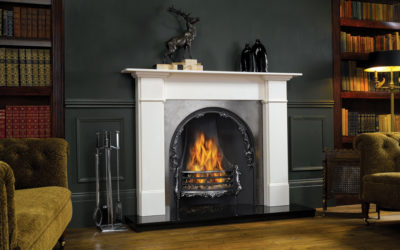If you’re choosing a new fireplace, one of the biggest questions you’ll face is: which type is the most efficient? Each option; wood, gas, and electric offers its own advantages in terms of heat output, energy use, and running costs.
At House of Fires Malvern, we help homeowners across Worcestershire and Herefordshire find the perfect balance between performance, style, and sustainability. Whether you’re drawn to the rustic charm of a wood burner, the instant convenience of gas, or the clean simplicity of electric, understanding efficiency is the key to making the right choice.
Understanding Fireplace Efficiency
Fireplace efficiency refers to how much of the energy produced by your appliance is converted into usable heat for your room.
- Traditional open fires can lose up to 80% of heat through the chimney.
- Modern stoves and enclosed fires achieve efficiency ratings of 70–90%.
- Electric models convert nearly 100% of electrical energy into room heat, though electricity costs can vary.
So, efficiency isn’t just about numbers, it’s about how that energy is generated, retained, and distributed in your living space.
1. Wood-Burning Fireplaces: Sustainable Warmth
Few heating options are as atmospheric as a real wood fire. Modern wood-burning stoves have come a long way from traditional open hearths, offering clean-burn technology and impressive energy performance.
Efficiency
- Modern wood stoves achieve up to 80–85% efficiency when used correctly.
- Use seasoned hardwood for best results, it burns hotter and cleaner.
Advantages
- Renewable, carbon-neutral fuel (when sourced sustainably).
- Cosy, radiant heat with a timeless aesthetic.
- Independent of gas or electricity supply.
Considerations
- Requires regular maintenance and chimney sweeping.
- Fuel storage space needed.
- Installation costs can be higher for homes without an existing flue.
Best for: Rural homeowners or those who value authentic flame and self-sufficient heating.
2. Gas Fireplaces: Efficient, Convenient Heat
Gas fires combine real flame visuals with easy control and high efficiency, perfect for busy households wanting warmth at the flick of a switch.
Efficiency
- Balanced-flue and glass-fronted gas fires reach up to 90% efficiency.
- Instant heat output with minimal energy waste.
Advantages
- Constant, controllable warmth with remote or app-based operation.
- Low maintenance and no need for fuel storage.
- Compatible with most home types, even without a chimney (via flue systems).
Considerations
- Requires a Gas Safe-certified installation.
- Relies on a gas connection or LPG supply.
- Slightly less “off-grid” than wood-burning alternatives.
Best for: Homeowners in Worcester or urban areas seeking practical, stylish, and efficient heating with minimal upkeep.
3. Electric Fireplaces: 100% Efficient (on Paper)
Electric fires are often marketed as 100% efficient and technically, they are, since all the electricity used is converted into heat. But it’s important to note that electricity can be more expensive per kWh than gas or wood.
Efficiency
- 100% room heat efficiency (no flue required, no heat loss).
Advantages
- Quick installation — simply plug in and go.
- No emissions, fumes, or fuel storage.
- Stylish designs with realistic flame effects.
Considerations
- Running costs depend on electricity tariffs.
- Heat output usually capped around 2kW.
- Doesn’t provide the same radiant warmth as real flame models.
Best for: Modern apartments, small rooms, or supplementary heating in energy-efficient homes.
Comparing Running Costs in 2025
| Fireplace Type | Typical Efficiency | Running Cost* | Ideal Use |
| Wood-burning stove | 80–85% | £0.07–£0.10 per kWh | Rural & eco-conscious homes |
| Gas fire (balanced flue) | 85–90% | £0.09–£0.11 per kWh | Everyday family use |
| Electric fire | 100% | £0.25–£0.30 per kWh | Secondary/occasional heating |
*Estimated UK averages, 2025 energy prices
Which Fireplace Is Best for You?
- Choose wood if you value natural heat, sustainability, and a traditional look.
- Choose gas if you want efficient, instant warmth with low maintenance.
- Choose electric if you prioritise convenience, flexibility, and clean operation.
At House of Fires, our experts can help you compare models side by side, seeing real working displays and understanding exactly how each system performs in practice.
How House of Fires Can Help
From selection to installation, we provide a complete service:
- Expert advice on efficiency, emissions, and fuel types.
- Working displays of top-rated gas, electric, and wood models.
- Professional installation by Gas Safe and HETAS-certified engineers.
- Ongoing maintenance and servicing for long-term peace of mind.
Visit our Malvern fireplace showroom to experience the difference between wood, gas, and electric fires and find the right one for your home.
Final Thoughts
In 2025, energy efficiency isn’t just a luxury, it’s a lifestyle choice. Whether you’re drawn to the authenticity of a log burner, the convenience of gas, or the simplicity of electric, the right fireplace should make your home warmer, greener, and more inviting.
Book your consultation with House of Fires Malvern today, and let our experts help you choose a fire that combines timeless design with 21st-century performance.
FAQs
1. Which type of fireplace is most efficient overall?
Balanced-flue gas fires and modern clean-burn wood stoves typically offer the best mix of efficiency, cost, and warmth.
2. Are electric fireplaces cheaper to run than gas?
Not usually. While 100% efficient, electric fires often cost more per kWh to operate, making gas more economical for regular use.
3. Can a wood-burning stove heat an entire home?
Yes, some models can connect to central heating systems or radiators, our specialists can advise if this is suitable for your property.



